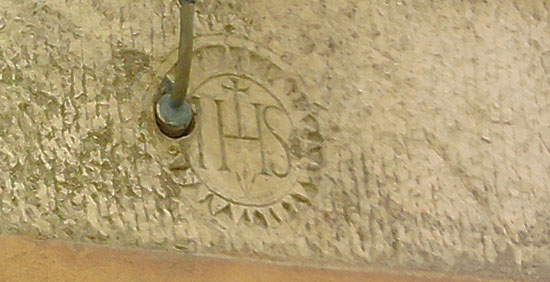The christogram of Via Santa Maria in Carrara: the punctured memory
At first glance it arouses hilarity, because an ancient christogram that has been pierced to pass a cable cannot help but bring a smile to one’s face when thinking of the creator of the masterpiece (and by masterpiece, of course, we mean the hole), but soon the hilarity gives way toindignation first of all because anancient work has been defaced, and then because there is nothing to prevent us from thinking that, like this one, other testimonies of our past will have suffered the same fate (if not a worse one).
A christogram is a combination of characters and images that recalls the figure of Christ, and christograms have always been used by Christians throughout the centuries: the one we see in the image is located in Carrara, on Santa Maria Street, and is composed of the three letters "IHS," or the first three letters of the name of Jesus in ancient Greek, “Iesous” (the “H” is actually an “eta” that is pronounced more or less like an “e” of ours). This abbreviation is also known as the “trigram of St. Bernardine of Siena,” since according to tradition he was the first to use it.
The three characters are inscribed in a sun, and we see that the H is surmounted by a cross and under the same letter there is room for three nails: this way of representing the trigram is similar to that adopted by the Jesuits, so much so that the emblem of the order is nothing more than the trigram IHS (with cross and nails) inserted in a disk with rays and flames. The work we see in the photo can also be dated to the 17th century because in the same area of the city there are other similar christograms, which, however, unlike this one, are dated.
The historic center of Carrara (as well as that of other cities in Italy) is full of christograms, bas-reliefs,
But the real value of these images that can be found on walls throughout the city is their historical importance, as evidence of a popular devotion that constituted a bit of a. how to say, an “alternative” to the official one of the time with the great masterpieces, the great cycles, the great apparatuses. Symbols with which our ancestors identified themselves. And in addition, we should not forget the value that these works had for all those who went to places of pilgrimage (the Via Francigena passed through Carrara): in front of these images, pilgrims stopped to pray and for them they constituted almost an incitement to continue the journey.
So this seems to be the way we care to treat the memory of our historic centers: by piercing it. And perhaps we should also consider ourselves almost lucky that we can still see this trigram intact (hole aside), because many of its counterparts will probably get even worse. And just as likely, many of those who puncture four-century old works will be the same ones who think that we in Italy have 50 percent of the world’s artistic heritage... so in the end who cares about a measly trigram, anyway “we have 50 percent of the world’s artistic heritage,” no one will pay attention to an anonymous sequence of characters above a wall.
And this is just one example: a very small, poorly preserved work that no one cares about... and so why not consider that just as small works are neglected, the same thing should happen to large (but, mind you: not famous) works? Even having a pierced seventeenth-century trigram is a consequence of a cultural policy that aims to make known only those five to ten world-famous masterpieces without bothering to take care of everything else. Even a paltry christogram on a wall of a medieval street in Carrara unknown to most, however, is a historical testimony, and even a paltry christogram is part of the memory of the people. But given the way things are going, perhaps we should count ourselves lucky if we can still see it there in its place, despite the hole.
Warning: the translation into English of the original Italian article was created using automatic tools. We undertake to review all articles, but we do not guarantee the total absence of inaccuracies in the translation due to the program. You can find the original by clicking on the ITA button. If you find any mistake,please contact us.






























